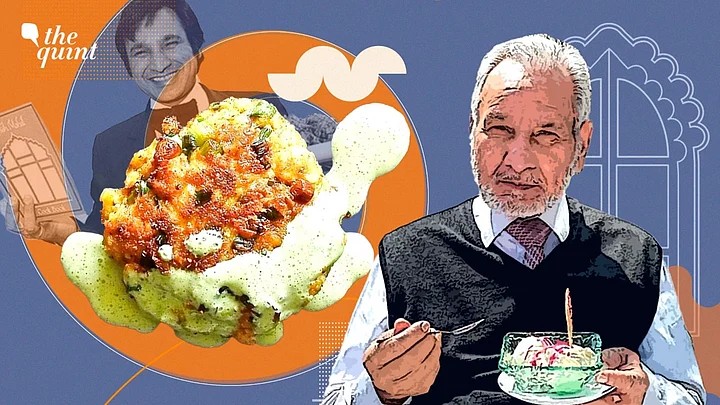On the day of Christmas last year, Ali Ahmed Aslam, the Pakistani-born Scottish chef, often credited with the invention of ubiquitous chicken tikka masala, was admitted to the hospital. “His head was slumped down. I stayed for 10 minutes. Before I left, he lifted his head and said you should be at work ... the restaurant was his life,” remembers Andleeb Ahmed, Aslam’s nephew.
Mr Ali, as he was known to his customers, opened his Shish Mahal restaurant in 1964 and changed the identity of Indian cuisine, forever.
Ali Aslam died earlier this week at the age of 77 due to septic shock and organ failure after a prolonged illness, leaving behind his wife, Kalsoom Akhtar, their five children, and an enduring legacy of popularising south Asian cuisine in the United Kingdom.
Lahore to Glasgow
Ali Ahmed Aslam was born into a family of farmers in a small village near Lahore, Pakistan. As an adolescent at the age of 16, he arrived in Glasgow in 1959 and worked in the clothes industry along with his uncle in the daylight and sliced onions at a local restaurant during the night.
As a self-driven individual, Ali soon opened his own restaurant in the city’s West End. At the beginning, he only had a handful of tables and a nice tandoor oven to serve his customers. His parents arrived from Pakistan to help him in the kitchen.
In 1969, he married Kalsoom Akhtar, who also hailed from the same village in Pakistan, and they soon became parents to five children – Shaista Ali-Sattar, Rashaid Ali, Omar Ali, Samiya Ali, and Asif Ali.
The Birth of Chicken Tikka Masala
“On a typical dark, wet Glasgow night in 1971, a bus driver coming off shift came in and ordered a chicken curry. He sent it back to the waiter, saying it is dry,” narrates Asif Ali on a 2013 episode of the British TV cookery programme, Hairy Bikers.
Ali went on to explain that his father was eating tomato soup and was suffering from an ulcer at the time.
“To please his guest, he thought, ‘Why not put some tomato soup into the curry with some spices?’ They sent it back to the table and the bus driver absolutely loved it. He and his friends came back again and we put it on the menu.”Asif Ali, son of Ali Aslam
“He never really put so much importance on it,” Asif Ali adds. “He just told people how he made it.”
The chicken tikka masala created by chef Ali Aslam changed the palate of a nation, argues Asma Khan, a celebrity chef and restaurateur who was the first British chef on Netflix’s Chef’s Table.
“The small innovation of adding a mild creamy gravy to a chicken dish had a seismic impact as it made a dish less “foreign” – it toned down the chillies. The rest as they say is history.”Asma Khan, celebrity chef
Since then, the number of south Asian restaurants in the United Kingdom has exponentially expanded, and today there are approximately 8500 of them in the country.
An Indisputable South Asian Lineage
While chicken tikka masala has only been around since the 1970s, its origins have a much longer history – well, at least the tikka part – and without that, there would be no chicken tikka masala.
Chicken tikka masala is a south Asian cuisine that consists of chunks of chicken marinated in a fiery reddish orange (depending on spice levels) sauce and is typically served with a portion of whole grain, such as naan or rice.
Though Ali Aslam is largely attributed as the pioneer of chicken tikka masala (CTM), other curry restaurants and kitchens in the UK have also claimed its ownership – suggesting that the dish was most likely not one person’s invention.
With an indisputable south Asian lineage and Britain’s favourite curry, some claim its origin in Birmingham whereas some in Punjab. While some, such as chef Anjum Anand, believe it originated with the butter chicken at the Moti Mahal in Delhi in the 1950s.
However, every simultaneous discovery was intrinsically tied with the addition of cream, yogurt, tomatoes and garam masala – a distinct and blatant fusion of British and Desi tastes and traditions.
Symbol of Modern Multicultural Britain
The south Asian curry saw its zenith in the curry houses of 1970s Britain and sooner became a cultural and powerful symbol.
In 2001, the former Shadow Secretary of State for Health and Social Care of the United Kingdom, Robin Cook, complimented the dish and declared chicken tikka masala to be “a truly British national cuisine.”
While alluding to a survey that showed it was more popular than fish and chips, he said,
“Not only because it is the most popular, but also because it is an excellent example of how Britain absorbs and adapts to external influences.”
Though if one considers the history of the British Empire and the post-1947 migration to the UK from the Indian subcontinent, it reveals how CTM has become a national dish in Britain.
The reason for this is not that CTM is the most liked dish or that it was invented in the United Kingdom; rather, it exemplifies how the British people have absorbed and adapted to ideas and influences from other countries.
Quite interestingly, according to some, the authentic representation of multicultural Britain today is chicken tikka masala.
The dish also played an enormous role in becoming part of the fabric of the south Asian diaspora. It reveals a shocking truth: the transformation shaping Indian cuisine, which is an amalgamation of contradictory cultural manifestations with a strong parallel with its rich history of a wide range of dishes famous across the world.
(Kalrav Joshi is a multimedia journalist based in London. He writes on politics, democracy, culture, and technology. He tweets @kalravjoshi_.)
(At The Quint, we question everything. Play an active role in shaping our journalism by becoming a member today.)
